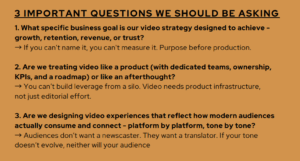2025-08-06. “We know video shapes the user experience because it is now how most stories are consumed. It's how they're remembered. And it's when, how and why our audiences are returning,” says Upasna Gautam, CNN's former Senior Product Management Leader. The post ‘Purpose before production’: Video offers opportunities, but strategy is vital appeared first on WAN-IFRA.
Video as a product is a powerful asset for news publishers because it offers “a combination of emotion, clarity and trust,” Gautam told our World News Media Congress participants in Krakow.
“Our audiences no longer want top-down delivery. They want storytelling that actually meets them where they are in a conversational, clear and emotionally intelligent way. This is how you build and earn trust at scale,” Gautam said.
Video is ‘closest thing to one-on-one human interaction’
Gautam has spent 17 years in tech, the past six of those at CNN, where she led the development of their new content publishing system, before leaving the broadcaster in May.
This content system not only includes everything CNN’s editors, journalists and producers use every day to distribute breaking news, but is “also very much a platform for our product and engineering team to be able to rapidly iterate and experiment and deploy new features,” she said.
In addition, Gautam has been chair of the Board of Directors for the News Product Alliance for the past year. This alliance is a community of more than 3,000 news product builders, leaders, and thinkers from local to large newsrooms worldwide.
Through her work at CNN and with the News Product Alliance, Gautam said she’s been able to see a wide variety of examples of video use from newsrooms of all sizes.
Video provides “the closest that our audience is going to get to one-on-one interaction with a human. This is why it adds so much emotional weight, clarity and recall,” she said.
‘We don’t have a video problem. We have a strategy problem.’
News publishers need to concentrate on their strategy with video, she said. Video needs to be treated like a product, she said: “That means it has to be clearly defined, and there must be ownership of that product.”
As with other products, there are a set of specific questions that need to be addressed. These include:
-
What are the goals?
-
What are the key success metrics?
-
What are the outcomes we are trying to achieve with the product?
“It’s not just about putting video out and shipping outputs. We need to really focus on building a strategy around it,” Gautam said.
What specific business goals is the video strategy designed to achieve?
- Is it growth?
- Is it retention?
- Is it revenue?
- Is it trust?
“If you cannot name it, you cannot measure it: so purpose before production,” she said.

WAN-IFRA Members can access the slides from Upasna Gautam’s presentation, as well as an audio replay of it on our Knowledge Hub.
“If you’re not designing for the human experience layer or the audience experience layer, you’re not building for how people actually engage,” Gautam said.
This is the core of many challenges publishers are seeing today, not just with video, but at a product level across news, she noted.
People want to feel like they’re connecting with another human being, not an expert. Specifically, Gautam said this means:
- Conversational tone
- Emotional intelligence
- Clarity, using clear language over jargon
Identify your top priority
“If I were rebuilding a video strategy from scratch, thinking about this communication issue and the product issue and how that ties to business metrics and product success, I would treat video as a key product development asset, define its business role, and build for real audience behaviour,” Gautam said.
“Get crystal clear on where you are in your journey, whether it’s product or business, and identify the top priority or problem to solve,” she added.
In order to do that, news publishers have to:
- Talk to their customers
- Talk to their users
- Talk to their community
“There’s absolutely no substitute for directly engaging and conducting user research,” she said.
This is true whether you’re building a tool internally for video production, for your users or editorial staff, or you’re out in your community or your region and creating content for them, she added.
Publishers have to find out:
- What resonates with their users?
- What pisses them off?
- What is it they need?
For example, if a publisher has a community journalist explaining something like tarrifs in a way that breaks it down and makes sense, “that’s how you solve problems,” Gautam said. “That’s how you build trust with your community.
‘How is this going to affect me?’ ‘What is that going to mean for me?’

“If there’s one thing you all take away today, I hope it’s this slide, which is three important questions you should be asking in your organisations and yourself,” Gautam said.
The post ‘Purpose before production’: Video offers opportunities, but strategy is vital appeared first on WAN-IFRA.











